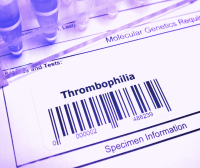Understanding Thrombophilia
Genetic Clotting Disorders. The Basics.


The Basics of Thrombophilia
Thrombophilia is a medical condition characterized by an increased tendency to develop blood clots. This condition can lead to various complications, including deep vein thrombosis (DVT) and pulmonary embolism (PE). A DVT is a blood clot in the deep veins of a person’s leg or arm. A DVT can grow larger or break off and travel to a person’s lung as a potentially life-threatening PE.
Thrombophilia can be either acquired or inherited.
Acquired Thrombophilia refers to a condition where an individual develops an increased tendency to form blood clots due to factors acquired during their lifetime. Acquired thrombophilia can result from various medical conditions or external factors, such as: prolonged immobilization, hormonal therapies (like estrogen-based contraceptives or hormone replacement therapy), smoking, obesity, pregnancy, or medical conditions like cancer or autoimmune disorders like antiphospholipid syndrome. These factors can disrupt the normal balance of the blood clotting process, leading to an increased risk of clot formation.
Inherited or Genetic Thrombophilia is caused by genetic mutations affecting the blood clotting system and can be inherited, meaning it is passed from parents to their children. Genetic thrombophilia is linked to specific inherited mutations that affect the blood clotting process. These genetic abnormalities can lead to an imbalance in the coagulation system, increasing the risk for abnormal clot formation.
The Clotting Cascade
To understand thrombophilia, it’s important to understand the blood clotting cascade. The process involves a complex relationship between clotting factors, proteins, and platelets that work together to form a stable blood clot in response to vascular injury. When this balance is disrupted, it can lead to abnormal clot formation, resulting in conditions like deep vein thrombosis (DVT), pulmonary embolism (PE), and other thrombotic events.

Forms of Genetic Thrombophilia
Some of the more common forms of genetic thrombophilia include:
- Factor V Leiden Mutation: One of the most common genetic mutations associated with thrombophilia is the factor V Leiden mutation. It affects up to 8 percent of the U.S. and European general populations. This mutation involves a change in one of the clotting factors, factor V, making it resistant to inactivation by protein C, which plays an important role in blood clotting. As a result, individuals with this mutation have an increased risk of developing blood clots. When a person inherits this gene mutation from one parent, their lifetime risk for thrombosis increases about 7-fold. On the rare occasion when a person inherits the factor V Leiden gene mutation from both parents the risk increases by about 20-fold. 1,2,3
- Prothrombin Gene Mutation (G20210A): Another common genetic mutation linked to thrombophilia is the prothrombin gene mutation. This mutation involves a change in the prothrombin gene, leading to increased levels of prothrombin (a clotting protein). Elevated prothrombin levels can predispose individuals to clot formation. This gene mutation is seen mostly in Caucasian individuals, particularly among individuals in Southern Europe and in the Mediterranean region of the world. In the U.S., its general prevalence has been shown to be as high as 5 percent among Caucasians, 0.3 percent among the Black population, and up to 2.4 percent in Hispanics. Worldwide, prothrombin gene mutation (G20210A) has been shown to be virtually negligible among people of Asian descent.4
- Protein C and Protein S Deficiencies: Protein C and protein S are two proteins that play a crucial role in regulating blood clotting. Deficiencies in either of these proteins can lead to an increased risk of clot formation. Individuals with protein C or protein S deficiencies may develop blood clots in veins, posing a risk of complications such as pulmonary embolism. The incidence of protein C deficiency ranges from about 1 in 200 to 1 in 500 people, and experts say that there are no known racial or ethnic patterns in its prevalence. The prevalence of protein S deficiency is estimated to range from .03 to .13 percent, but presently the exact number of people affected is unknown.5
- Antithrombin Deficiency: Antithrombin is a natural anticoagulant that helps regulate blood clotting. Genetic mutations that result in antithrombin deficiency can disrupt the balance between clot formation and dissolution, increasing the risk of abnormal blood clotting. While it is a much more rare form of thrombophilia, it poses the greatest clotting risk compared to other forms of thrombophilia, and the risk for clotting among people with antithrombin deficiency increases significantly with age, beginning at about age 20. About 50 percent of people affected by antithrombin deficiency experience a blood clot by the time they reach the age of 50. People with antithrombin deficiency are at increased risk for recurrent clots. The prevalence of antithrombin deficiency ranges from 1 in 500 to 1 in 5,000 in the general population, and there are no racial or ethnic patterns in its prevalence.6
To learn more about genetic testing in thrombophilia, click here.
To learn more about genetic testing and women’s health in general, click here.
To learn more about thrombophilia testing and contraception, click here.


